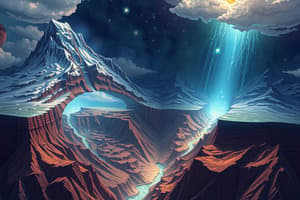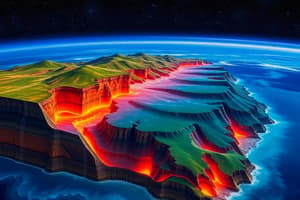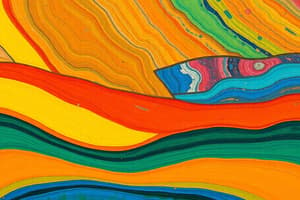Podcast
Questions and Answers
What happens when a continental plate collides with an oceanic plate?
What happens when a continental plate collides with an oceanic plate?
The denser oceanic crust gets bent and pulled under, or subducted, beneath the lighter and thicker continental crust.
What is a subduction zone?
What is a subduction zone?
A subduction zone is where the denser oceanic crust gets bent and pulled under the lighter and thicker continental crust.
What is a trench and what forms it?
What is a trench and what forms it?
A trench is a deep oceanic valley formed at the edge of the continent.
What does the magma formed at the subduction zone do?
What does the magma formed at the subduction zone do?
What happens when two oceanic plates collide?
What happens when two oceanic plates collide?
What are island arcs and what forms them?
What are island arcs and what forms them?
What happens when two continental plates collide?
What happens when two continental plates collide?
What happens at divergent boundaries found in the middle of the ocean?
What happens at divergent boundaries found in the middle of the ocean?
What happens when two continental plates diverge?
What happens when two continental plates diverge?
What features form along the rifts?
What features form along the rifts?
What is a fault and what causes them?
What is a fault and what causes them?
Why do transform boundaries and the resulting faults produce earthquakes?
Why do transform boundaries and the resulting faults produce earthquakes?
What is the name of the type of fault created at a transform plate boundary?
What is the name of the type of fault created at a transform plate boundary?
What is the name of the most famous of these faults?
What is the name of the most famous of these faults?
Describe what is happening at a fault.
Describe what is happening at a fault.
Where is a trench formed?
Where is a trench formed?
What happens when crust continues to be forced deeper into the earth?
What happens when crust continues to be forced deeper into the earth?
What do magma chambers do?
What do magma chambers do?
What happens when two oceanic plates collide?
What happens when two oceanic plates collide?
What are examples of island arcs?
What are examples of island arcs?
Earthquakes generated in a subduction zone can also give rise to what?
Earthquakes generated in a subduction zone can also give rise to what?
What is a tsunami?
What is a tsunami?
What happens when two continental plates collide?
What happens when two continental plates collide?
What is the name of the type of fault created at a transform plate boundary?
What is the name of the type of fault created at a transform plate boundary?
What happens when two continental plates diverge?
What happens when two continental plates diverge?
What features form along the rifts?
What features form along the rifts?
What is a trench?
What is a trench?
What way does a synclinal layer go?
What way does a synclinal layer go?
What way does the anticlinal layer go?
What way does the anticlinal layer go?
Flashcards are hidden until you start studying
Study Notes
Continental and Oceanic Plate Interactions
- Oceanic crust is denser and thinner compared to continental crust, leading to subduction when they collide.
- In subduction zones, the denser oceanic crust is pulled beneath the lighter continental crust.
- The collision often leads to the formation of oceanic trenches at the edge of continents.
Magma Formation
- Subducted crust is subjected to high heat and pressure, releasing trapped water and gases.
- This process causes the base of the crust to melt, resulting in magma.
Oceanic Plate Interaction
- When two oceanic plates collide, the older plate subducts beneath the younger one.
- This can lead to the formation of volcanic island arcs, such as the Mariana and Aleutian Islands.
Continental Plate Collision
- When two continental plates collide, their lighter and less dense rock resists being subducted, preventing magma formation.
- Continental collision results in mountain formation due to the crunching and folding of rocks.
Divergence and Rifting
- At divergent boundaries in the ocean, magma rises to create new crust.
- Divergence between two continental plates also causes the rock at the boundary to crunch and fold, resulting in mountain ranges.
Faults and Earthquakes
- A fault is a crack in the Earth's crust linked to tectonic movement.
- Transform boundaries, where plates slide past each other, often produce earthquakes due to jagged plate edges.
- The most notable type of fault at transform boundaries is the strike-slip fault.
Tsunamis
- Earthquakes in subduction zones can lead to tsunamis, which are massive ocean waves caused by shifts in the ocean floor.
Geographic Features
- Trenches form at the edges of continents where subduction occurs.
- Mountain ranges are created along rifts where tectonic plates diverge or converge.
Additional Concepts
- A trench is defined as a long, narrow ditch, often associated with subduction zones.
- Synclinal layers dip downward, while animal levels refer to elevations going upward.
Studying That Suits You
Use AI to generate personalized quizzes and flashcards to suit your learning preferences.




